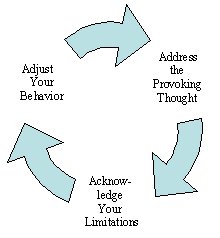- By Matthew P. Binkewicz, Lansing Counseling Service
- Around Town
 Print
Print  Healing WellKnowing how to let go of any unhealthy habit is a key component to living a well balanced life. If you are someone who has control issues, you need to reshape the way you deal with everyday situations as well as stressful ones. In a similar manner, you will need to readdress how you deal with individuals both in the workplace and at home. Finding the right technique that enables you to free yourself from control issues will allow you to improve you personal self-esteem and accept personal responsibility for your own thoughts, words, and actions.
Healing WellKnowing how to let go of any unhealthy habit is a key component to living a well balanced life. If you are someone who has control issues, you need to reshape the way you deal with everyday situations as well as stressful ones. In a similar manner, you will need to readdress how you deal with individuals both in the workplace and at home. Finding the right technique that enables you to free yourself from control issues will allow you to improve you personal self-esteem and accept personal responsibility for your own thoughts, words, and actions. As with any imbalance in life, you need to recognize the stressors that set off dysfunctional behavior. The desire to control all events and individuals in life may originate with the need to have complete control, change, fix, rescue, advise, or correct a situation you deem in need of repair (whether it actually needs repair or not). This desire to make right any situation will have dire consequence as tension will increase along with anxiety, and other unhealthy side effects.
A way to deal with control issues begins with your initial thoughts when you face a situation in which you think needs your immediate attention. Again, it is your perception that a person or event is in need of repair, when in reality, it is just fine the way it is. Rather, it is you who are in need of repair.

Step 1: Address the Provoking Thought
Recognizing the stressors that set off controlling behavior is the start toward healing. Each situation or individual with whom you come into contact is an opportunity to pause and carefully examine just what or who needs to change. There is a limit to what we can control or change. But one thing is for certain, we can always change ourselves. Sit down and ask yourself a few simple questions. The following are just a few that will help you in this first step.
Does the situation need to be changed? Is it working or producing as it should? Did anyone ask me to “fix” it? Does the person or people in my life need constant adjustment like the vertical hold on a television set? By taking some time to examine yourself, you might discover that the situation or individual is just fine.
Step 2: Acknowledge Your Limitations
This step is a simple reminder that some things in life cannot be changed. No matter how much power we possess or desire change, there are some situations that are simply unchangeable. There is just one thing that we have the ability to change, and that is ourselves. We ought to have a real desire for change, one that brings about a positive transformation of our behavior and attitude with those around us.
Step 3: Adjust Your Behavior
Once you have accepted the fact that change originates at the level of one’s self, you will find it easier to alter your own behavior. Rather than insisting on others to change according to your preconceived notion of what is best, you will need to accept responsibility for your own life. You will need to take steps to stop the desire to control, fix, change, rescue, enable, give advice, or correct other people, places, or things.
We need to allow others to experience the natural consequences of their own thoughts, emotions, and actions. Each of us learns through experience and not by being told what to do or how to think. Life’s greatest learning comes not only through successes, but also through the failures and near misses. Learn to Address-Acknowledge-Adjust to the situations and individuals in your life, and see how quickly others learn by your example.
· L - Lighten Pressure
· E - Exercise Rights
· T - Take Steps
· G - Give Up Need
· O - Order Life
L - Lighten Pressure
The first thing you need to do is to lighten the pressure when you feel the psychological need or compulsive drive to control, change, fix, rescue, enable, give advice, or correct other people, places, or things. To do this, use the TEA, ALERT, ANGER and CHILD Systems to help you become more rational and realistic about your current pressure or compulsive drive to control.
E - Exercise Rights
Second, once you have regained a healthier, more rational and realistic perspective on the current person, place, or thing you want to control, you need to exercise your right to declare that you can only change or control one thing and that is you.
T - Take Steps
G - Give Up Need
Serenity Prayer - By Reinhold Niebuhr
· God, grant me the serenity
· to accept the things I cannot change
· Courage to change the things I can,
· Wisdom to know the difference,
· Living one day at a time,
· Enjoying one moment at a time,
· Accepting hardship as a pathway to peace,
· Taking as Jesus did this sinful world
· as it is, not as I would have it.
· Trusting that you will make all things right
· If I surrender to your will.
· So that I might be reasonably happy in this life
· and supremely happy with you forever in the next.
----
v3i5



